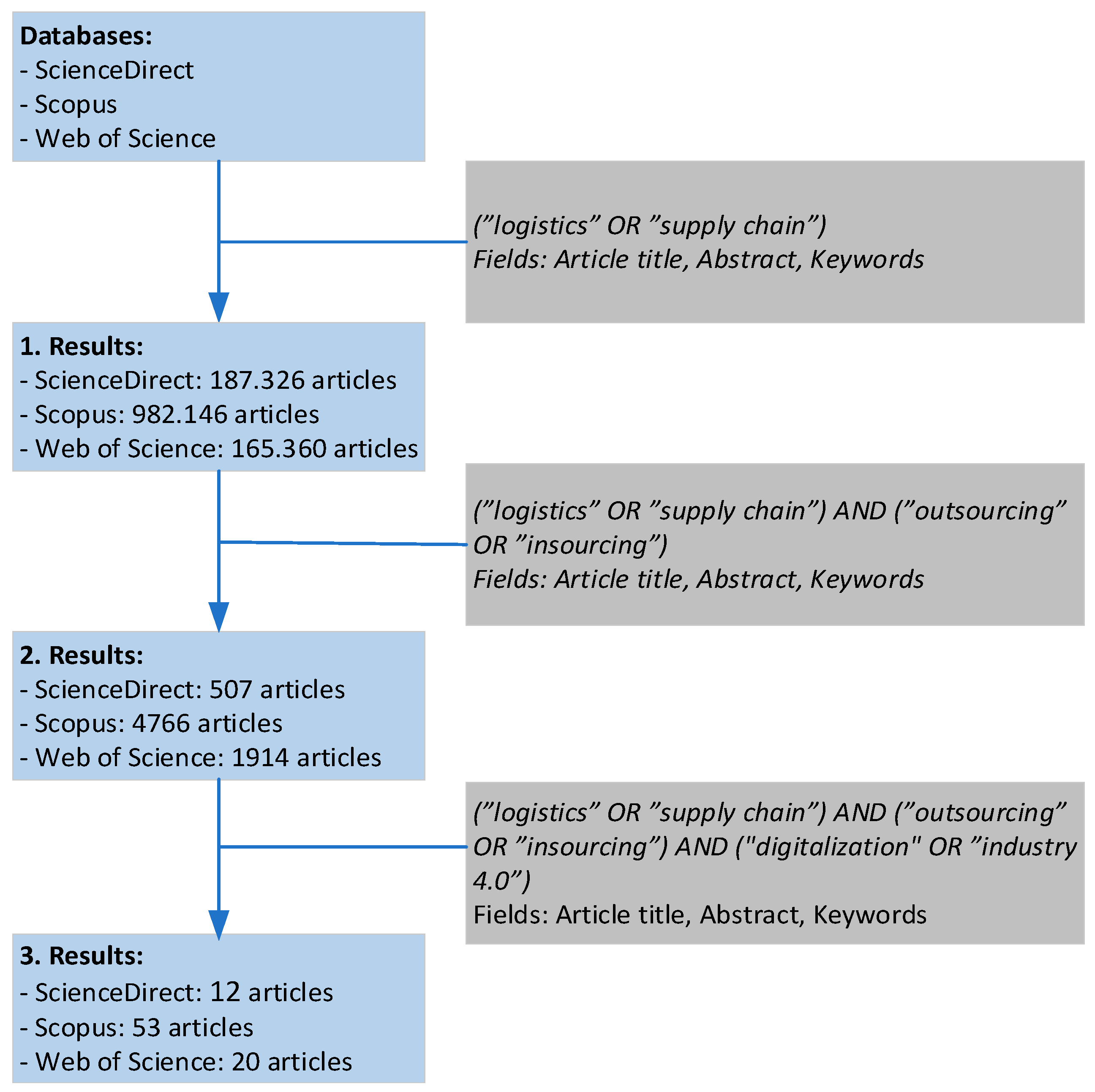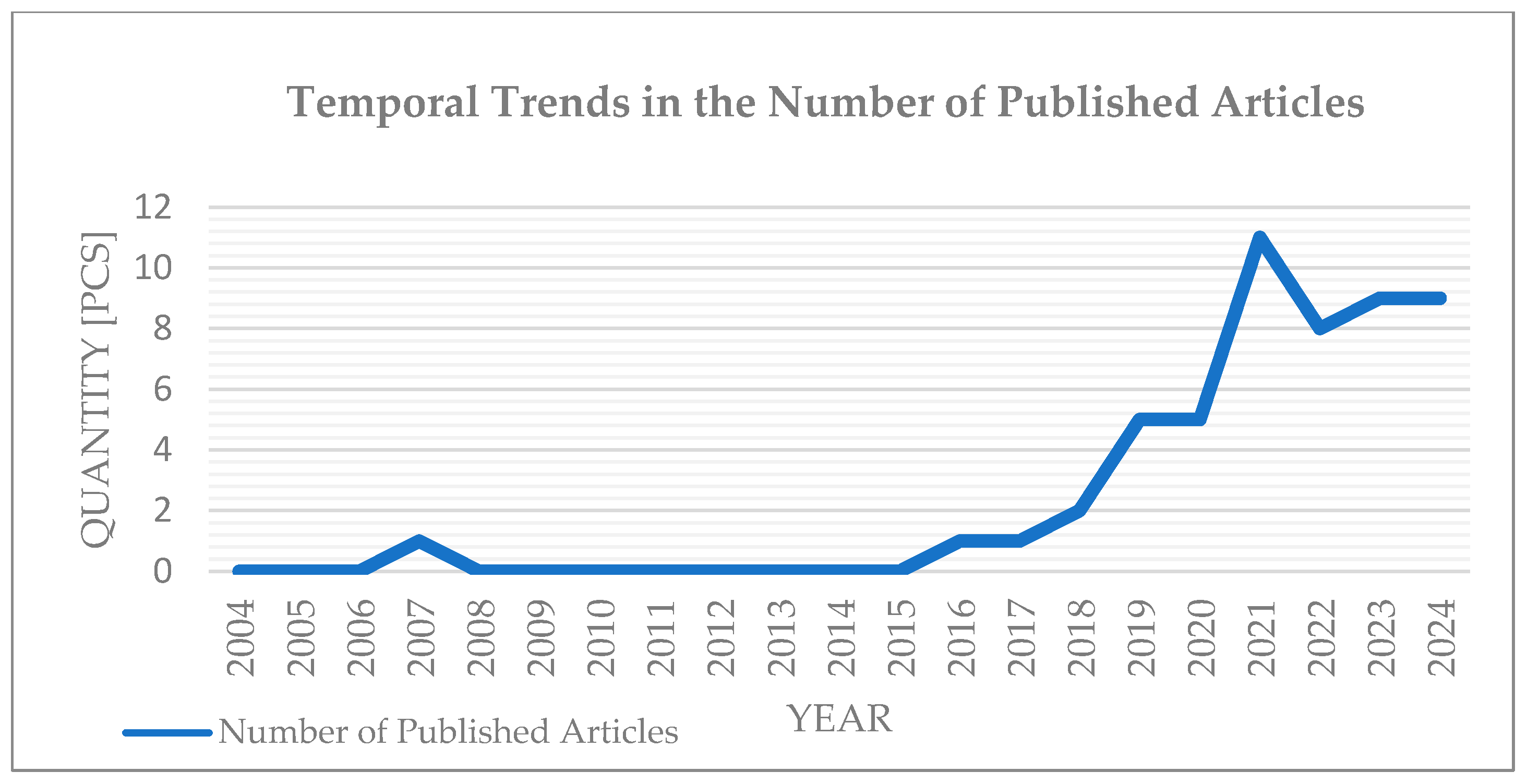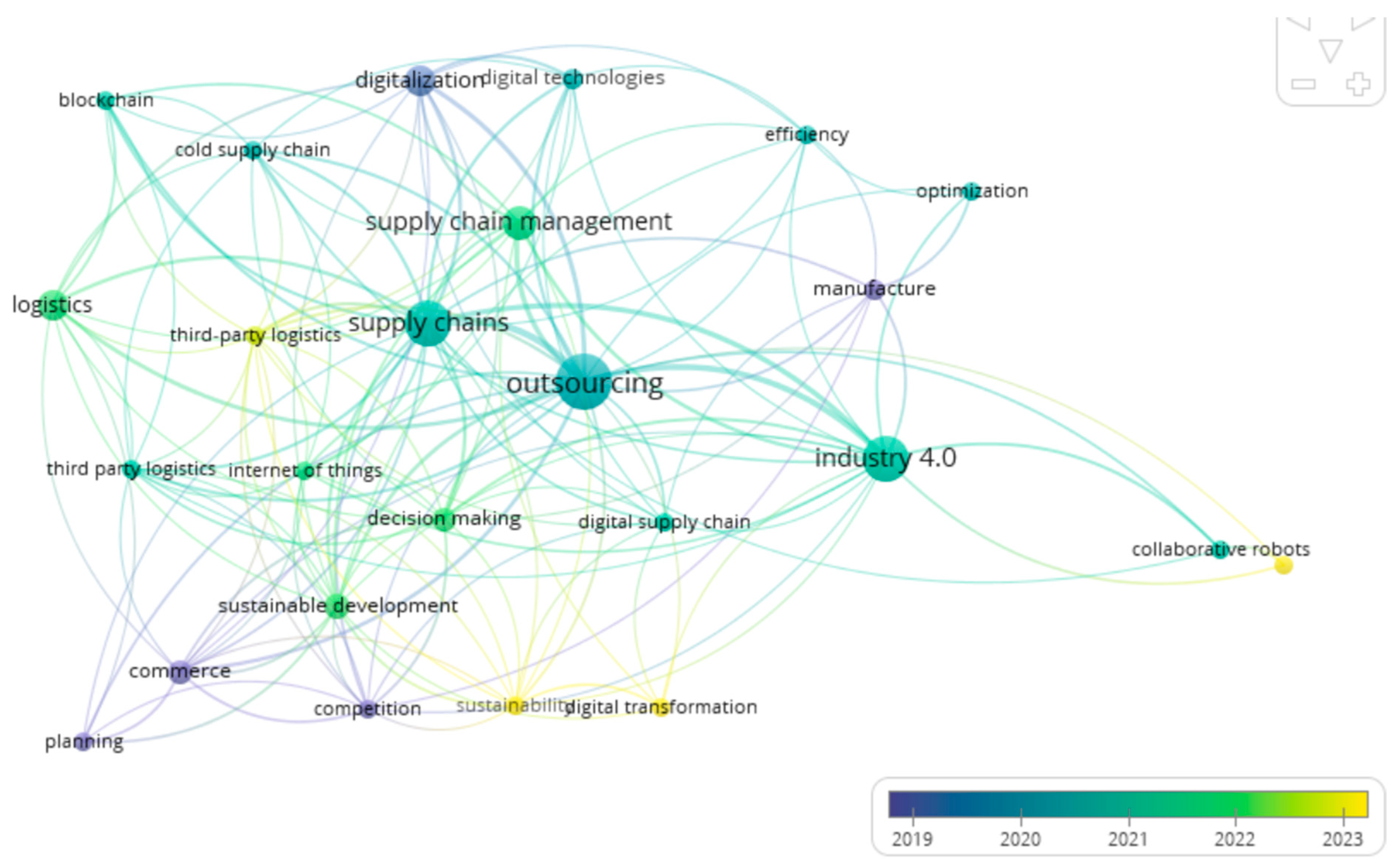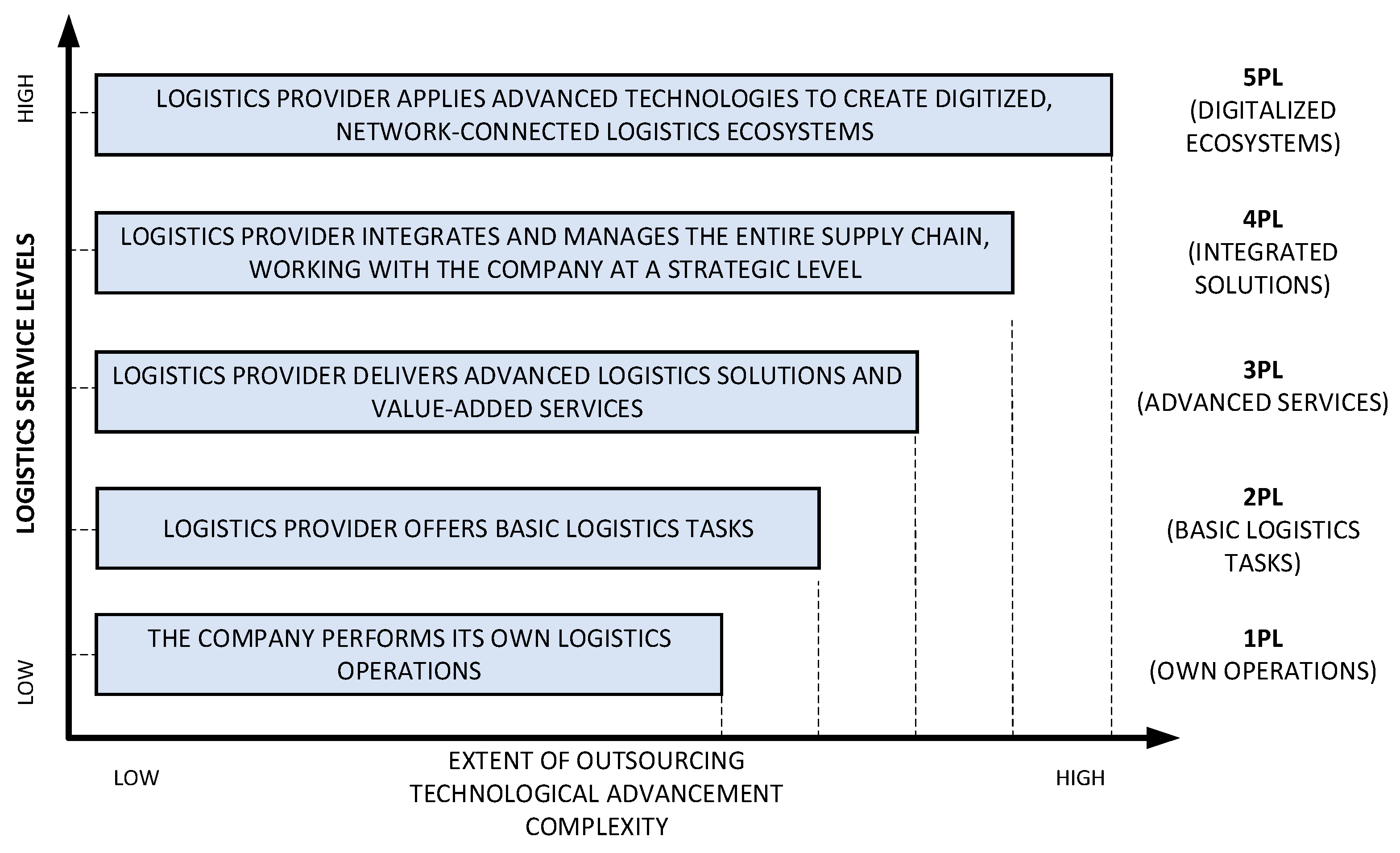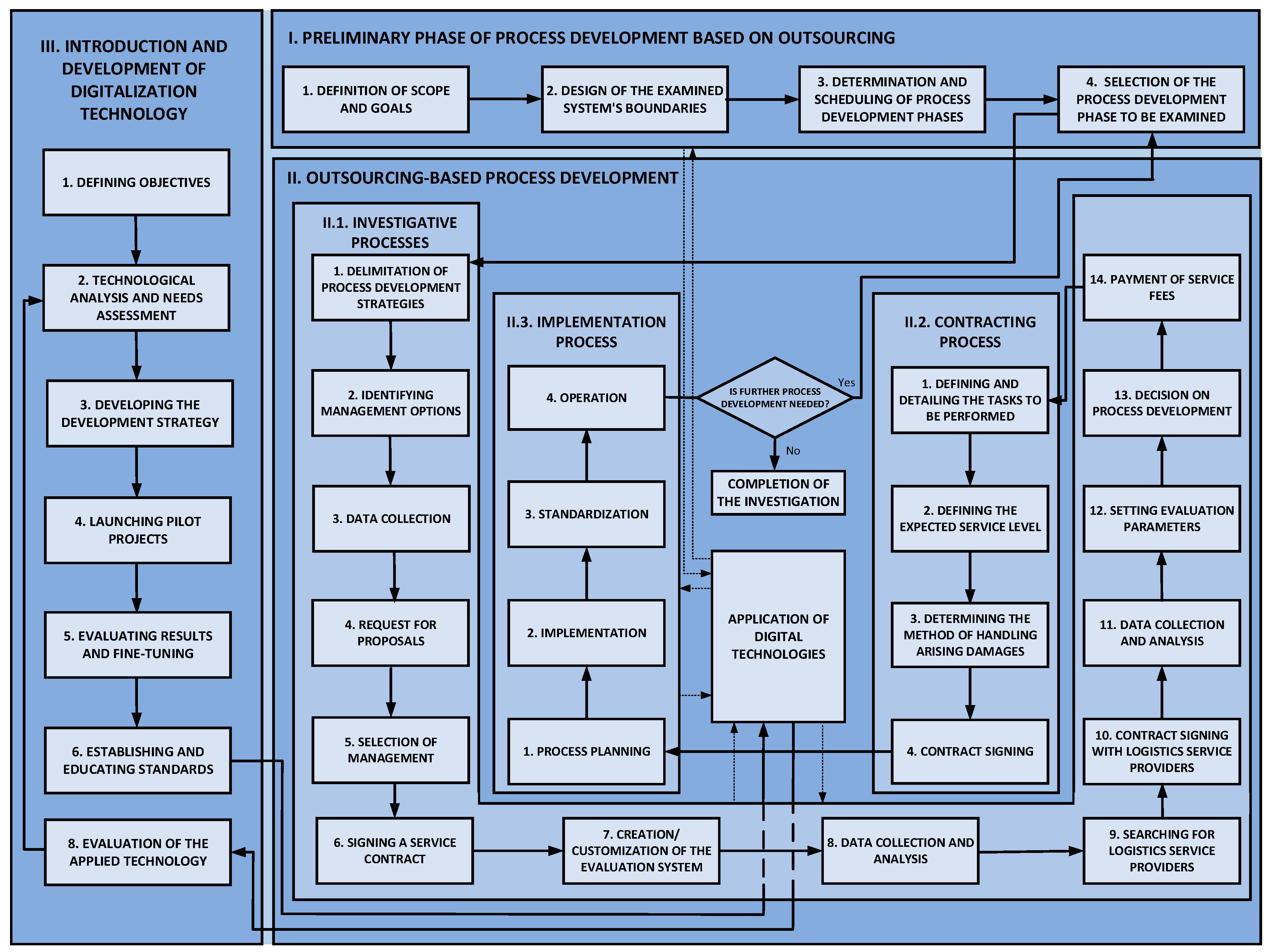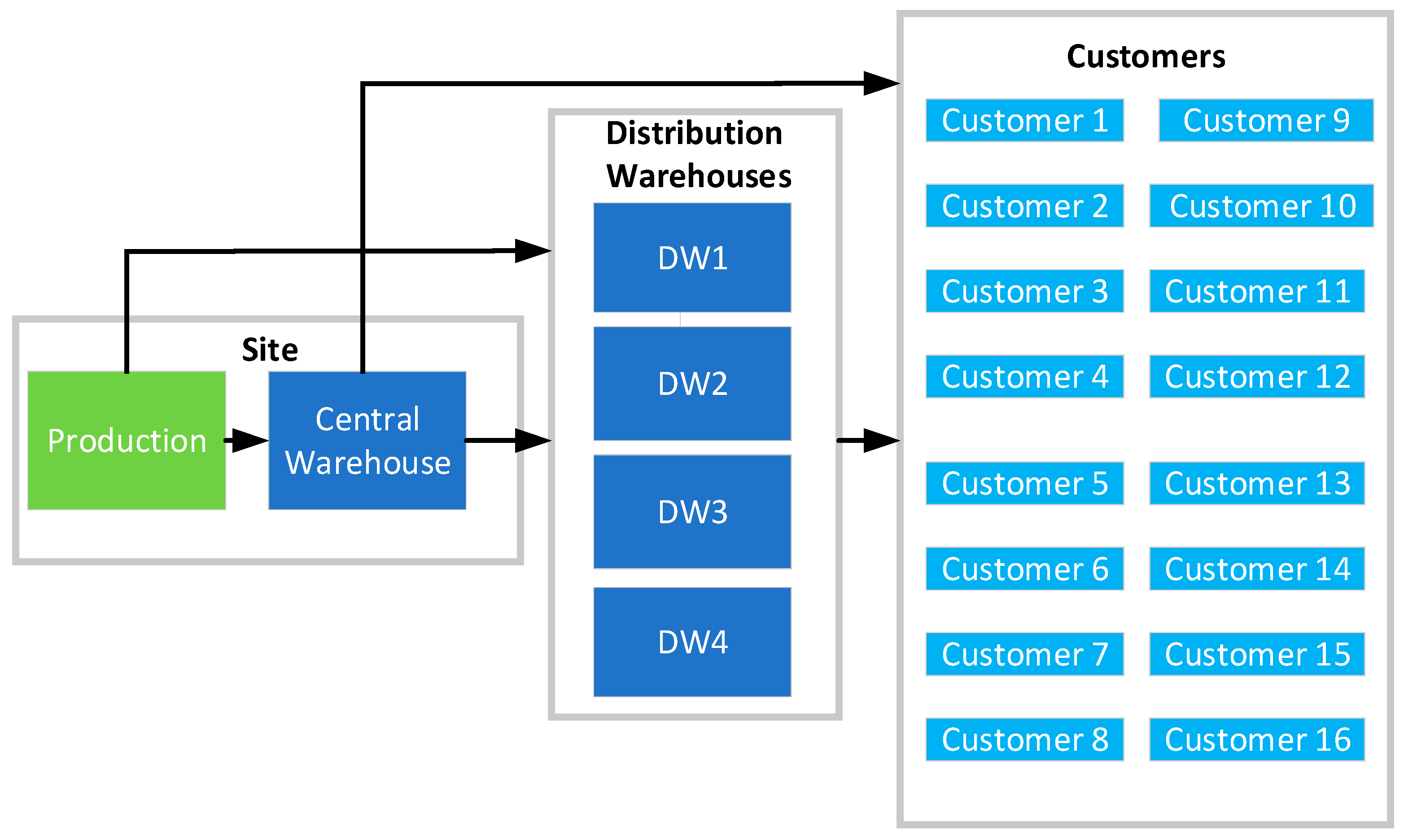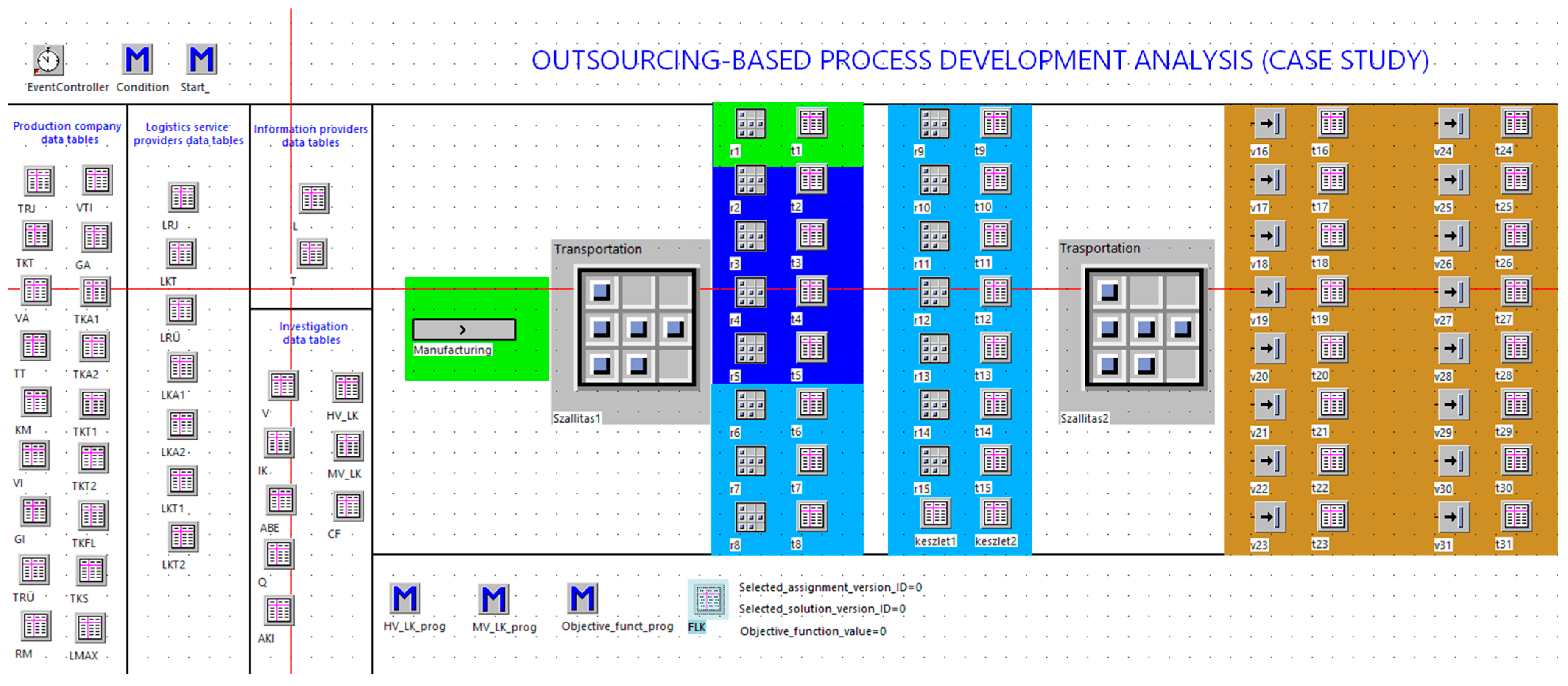2. Systematic Literature Review to Identify Scientific Gaps
To examine the development of the studied field and uncover current scientific gaps and development opportunities, I applied the method of systematic literature review [
10]. The steps of this method are illustrated in
Figure 1.
Steps of Systematic Literature Review:
1. Defining the Motivation: Over years of conducting industrial research, I have observed that the method of evaluating outsourcing decisions for logistics activities has a significant impact on companies’ competitiveness. In many cases, an inappropriate outsourcing alternative was selected, resulting in insourcing decisions. My primary motivation for the literature analysis was to understand the methodologies currently used in this field and to uncover their shortcomings.
2. Defining Research Questions: During the literature analysis of the research topic, I sought answers to the following questions:
What are the trends in outsourcing evaluations for logistics activities?
What evaluation methods are applied?
What are the shortcomings of the currently applied methodologies?
3. Determining Keywords and Their Combinations: To answer the research questions, the objective was to identify keywords that could uncover relevant publications in the examined field.
Keywords:
“logistics” OR “supply chain”;
“outsourcing” OR “insourcing”;
“digitalization” OR “industry 4.0”.
Keyword Search Combinations:
(“logistics” OR “supply chain”);
(“logistics” OR “supply chain”) AND (“outsourcing” OR “insourcing”);
(“logistics” OR “supply chain”) AND (“outsourcing” OR “insourcing”) AND (“digitalization” OR “industry 4.0”).
4. Conducting the Literature Analysis: The analysis of international literature over the past 20 years was conducted using three publication databases: Scopus, Web of Science, and ScienceDirect. As shown in
Figure 2, keyword search combinations were examined in the titles, abstracts, and keywords of articles. It was determined that the results from the third search combination contained publications most relevant to the research, and these formed the basis of the literature analysis. The Scopus database yielded the highest number of results and included the majority of publications found in ScienceDirect and Web of Science. Therefore, for further quantitative analysis, the Scopus database was selected as the primary focus.
The temporal distribution of publications related to the topic is illustrated in
Figure 3, which shows that relevant publications only started appearing after 2015. This can be attributed to the growing prominence of digitalization.
Additional relevant analytical data related to the examined field are presented in
Table 1, which indicates that research in this area holds significant importance in Russia, China, and Italy.
The metadata provided by Scopus was further analyzed using VOSviewer, a software designed for the visualization and analysis of scientific networks.
Figure 4 illustrates the relationships between the twenty-five keywords with at least three occurrences. It can be concluded that in recent years, new directions in outsourcing, such as digital transformation and sustainability, have emerged.
5. Selection of Relevant Publications: To compile a comprehensive evaluation of the international literature, I reviewed the abstracts of publications filtered from the ScienceDirect, Scopus, and Web of Science databases, and searched for additional relevant publications in the scholar.google.com database. Based on this process, I examined the abstracts of more than 100 publications, from which I selected the studies referenced in the following chapters.
6. Summary of Relevant Publications: The literature defines outsourcing as a process where a company transfers an activity it performs to a logistics service provider specialized in that activity [
7,
11]. The opposite of this process is referred to as insourcing, which may also involve establishing a previously non-existent competence [
3]. The process by which corporate control over a specific logistics activity is retained while part of the activity is outsourced is called cosourcing [
3]. Regarding the distance of outsourcing, a distinction is made between nearshore and offshore outsourcing (e.g., according to one approach, outsourcing to a country within the same time zone and continent is considered nearshore, while other cases are classified as offshore outsourcing) [
3,
12].
Advantages of Outsourcing:
Focus on Core Activities [
8,
12]: By outsourcing activities not directly tied to the core business, company leaders can dedicate more time to managing and developing areas that are more critical to the company’s success.
Lower Unit Costs for Logistics Services [
8]: Logistics service providers typically have larger logistics capacities and serve multiple clients, enabling economies of scale and resulting in lower unit costs.
Higher Service Quality [
3,
7]: Most logistics service providers are committed to continuously improving their services to maintain competitiveness, making higher service quality a likely outcome of outsourcing.
Deferred Investments [
8]: In cases where seasonal effects or uncertain market conditions create a need for additional logistics capacity beyond what is available, outsourcing can be a suitable alternative to investing in new resources.
Repurposing Freed-Up Capacity [
13]: By outsourcing logistics activities, resources can be freed up for other uses, such as revenue-generating activities.
Potential Risks of Outsourcing:
Risks from Poor Performance [
3]: If the logistics service provider lacks the necessary resources, expertise, or capabilities to fulfil the assigned tasks adequately [
13,
14].
Provider Bankruptcy and Theft [
15]: The financial stability of the logistics provider and the risk of theft of high-value products are significant concerns in outsourcing.
Misappropriation of Business Information [
16,
17]: In industries with intense competition, safeguarding business information is critical, as its theft can cause substantial harm to the outsourcing company.
Dependency [
14]: The company’s operations depend on the performance, reliability, and decisions of the external provider, which can introduce vulnerabilities.
Logistics services can be categorized into different levels, ranging from in-house solutions (1PL) to complex, technology-oriented services provided by external parties [
7]. Experience suggests that as the service levels increase, there is a natural progression in the degree of outsourcing, technological sophistication, complexity, and integration. These relationships are illustrated in
Figure 5.
It can be concluded that to achieve the benefits, both individual and integrated outsourcing of various primary, secondary, and tertiary logistics services across all logistics subsystems can be implemented. For example, [
18,
19] examined the outsourcing of warehousing and transportation tasks, [
14] focused on IT services, and [
20] explored the maintenance of conveyor systems, while [
21,
22,
23] investigated the opportunities and challenges of outsourcing complex logistics processes.
Unlike corporate process studies, the primary objective of the study by [
24] was to assess the logistics potential of a country’s regions and identify development directions, including outsourcing opportunities. The logistics outsourcing process, as generalized from major academic sources [
16,
25] and practical studies [
26,
27,
28], is illustrated in
Figure 6. This process can be divided into three main phases: the evaluation phase, the contracting phase, and the implementation phase.
The outsourcing evaluation process encompasses the steps from defining the objectives of outsourcing to selecting the logistics service provider(s). The contracting process involves detailing the tasks to be performed by the logistics service provider and concludes with the signing of the contract. The implementation phase of outsourcing spans from planning operational processes to performance feedback. The steps of these subprocesses are detailed in the study by [
29,
30].
A detailed literature review by [
31] aimed to systematize the decision-making criteria and techniques for selecting logistics service providers. The study found that the most popular multi-criteria decision-making methods were the Analytic Hierarchy Process (AHP), TOPSIS (Technique for Order of Preference by Similarity to Ideal Solution), and Fuzzy models. Additionally, the authors identified 44 different selection criteria, among which the most common were cost, accuracy (on-time delivery), and service quality. The authors of [
22] demonstrated the method of selecting a 3PL logistics service provider through a case study involving a Vietnamese manufacturing company. Their approach ranked decision-making criteria using Fuzzy AHP and then selected the most suitable provider with the Fuzzy MARCOS method. The authors concluded that future research should prioritize the inclusion of sustainability and the application of innovative technologies. According to [
14], the success of outsourcing is significantly influenced by risk management, which requires special attention to the timely identification of risks and the implementation of countermeasures aimed at minimizing them. Such countermeasures may include contractual guarantees, enhanced information security, and risk-sharing mechanisms. Reference [
20] presents the integration of the AHP method with a hierarchical structural framework, which helps identify, rank, and analyze the interrelations of parameters critical to outsourcing a maintenance process. This method provides support for making outsourcing decisions. The authors of [
7] conducted a detailed literature review to explore the strategic directions of outsourcing, offering guidance for companies conducting outsourcing evaluations. Technological innovation, sustainability, and the establishment of strategic partnerships are becoming strong trends in the outsourcing of logistics services. The authors of [
32], using structural equation modelling (SEM), found that the application of Industry 4.0 technologies has a significant impact on operational efficiency and competitiveness. Companies with low innovation propensity are more likely to attempt efficiency improvements through external providers, such as outsourcing, rather than internal developments.
The sustainable management of supply chains and outsourcing decisions are becoming increasingly interconnected, particularly in the circular economy, where the development of green, centralized supply chains and the optimization of outsourcing strategies can be crucial [
33].
Based on the literature review, it can be concluded that, in practice, a wide range of logistics services are outsourced; however, the related evaluation solutions are fragmented and, in almost all cases, lack the application of modern digitalization technologies. There is no comprehensive framework developed that considers the opportunities provided by new digitalization technologies to define and implement an optimal outsourcing-based process development solution.
3. Operational Concept of an Outsourcing-Based Process Development Framework
The operational concept of the framework was developed using an inductive–deductive methodology, which combines the practical experiences gained through corporate R&D projects I have been involved in with the findings of the systematic literature review presented in the previous section.
In the inductive phase, I evaluated my prior industrial experiences in the fields of outsourcing and process development. Among these projects was the examination of a paper mill’s entire distribution logistics system, where the assessment of outsourcing feasibility emerged as a central issue, as well as an analysis of a paint factory’s warehouse capacity expansion possibilities, where outsourcing was also considered a viable alternative. While these projects are not explicitly detailed in the paper, the practical insights gained contributed to the development of the evaluation model, particularly in identifying factors and methodological approaches that influence outsourcing decisions. Through the analysis of industrial experiences, I identified several key factors that may impact the effectiveness of outsourcing decisions in logistics:
The inconsistent application of evaluation standards, which in some cases may hinder efficient and objective assessments;
The varying degree of digital technology implementation, which can limit process transparency and optimization potential in certain organizations.
In the deductive phase, I conducted a systematic literature review based on these practical experiences, which highlighted key trends in the field and factors that could further improve outsourcing decision-making. This phase included the analysis of publication databases (Scopus, Web of Science, ScienceDirect) and an examination of literature trends, where the VOSviewer software was used to identify scientific networks and key research areas.
The evaluation model I developed integrates conclusions drawn from industrial experience with methodological approaches identified in the literature review, enabling the application of modern digital tools in outsourcing evaluations within logistics.
As illustrated in
Figure 7, the proposed framework consists of three main phases: (I) Preparation for outsourcing-based process development, (II) implementation of outsourcing-based process development, and (III) introduction and development of digital technologies.
The steps of Phases I, II, and III are executed in the order indicated by the solid arrows, while the dashed arrows represent optional steps that can supplement each subprocess, particularly through the application of digital technologies, which are discussed in the corresponding phase.
By default, the evaluation process consists of executing Phases I and II, but if digital technologies are integrated, the process extends to include Phase III, which may either precede or run parallel to the evaluation phase. The bidirectional relationship between Phases II and III allows for both the application of implemented digital technologies and the further refinement of digital solutions based on insights gained during their use.
The following sections outline the steps involved in applying the developed framework.
I. Preparation of Outsourcing-Based Process Development
This phase spans from defining the objective(s) of the study to selecting the phase of outsourcing-based process development to be examined. The preparation phase can be carried out with the involvement of the company’s internal experts and/or external specialists.
Steps in Preparing for Outsourcing-Based Process Development: Based on the observed unfavourable effects in practice (e.g., a high rate of delayed deliveries, excessive inventory, etc.) and the corresponding key performance indicator (KPI) values, the areas requiring improvement are identified, along with the necessary evaluation phases and their scheduling. The following sections outline the steps of this process.
I.1. Defining Background and Objective(s): Considering the current situation and the desired pace of development, it is necessary to determine the key performance indicators (KPIs) relevant to process development, their current and, expected target values, as well as the deadlines for achieving the objectives. When identifying the KPIs, special attention must be given to both the advantages and risks associated with outsourcing. Additionally, this step includes presenting the importance and background of the objectives to ensure commitment to their implementation.
I.2. Delimiting the System Under Study: Based on the defined objectives, it is essential to establish the material and information flow boundaries of the outsourcing-based process development examination.
I.3. Defining and Scheduling Process Development Phases: Considering the objective framework, the process development phases to be examined must be identified. These phases may be associated with specific areas (e.g., a particular plant or production line) and/or investigation periods. During this step, it is necessary to define the specifications of the process development phases in detail, including the phase name, the boundaries of the examined system, the types and target values of the key performance indicators (KPIs) to be achieved, and the completion deadline. In complex projects, different process development phases may apply to different sub-areas, which means that the types of KPIs used may differ from those defined in I.1. However, it is essential that the combined effect of implementing the process development phases achieves the target value(s) specified in I.1, with adjustments if necessary.
I.4. Selecting the Process Development Phase to Be Examined: Based on the preliminary schedule, the outsourcing-based process development phases to be implemented are designated either sequentially in time or with overlaps. Such phases may include, for instance, the outsourcing evaluation of activities like warehousing, packaging, and other logistics functions.
II. Outsourcing-Based Process Development
Outsourcing-based process development spans from the examination of the designated process development phase to the implementation of the development. This part of the framework is divided into three sequential phases and one supplementary phase: the evaluation process, the contracting process, the implementation process, and, where applicable, the application of supplementary digitalization technologies.
The following sections describe the characteristics and steps of these phases:
II.1. Investigative Process: This process spans from the concretization of investigative opportunities to the decision-making in process development.
Process steps:
1. Delimitation of Process Development Strategies: Based on the characteristics of the current process under examination and the company’s business policy, the range of strategies to be analyzed is defined. In some cases, only one strategy may be considered, while in others, all three strategies may be examined. The delimitation may include the following strategies:
Outsourcing: In this strategy, the examined activity is entirely transferred to a logistics service provider specialized in that activity, aiming to reduce costs and/or improve service quality [
3,
12].
Cosourcing: This strategy involves a collaborative model where the company and the partner jointly perform the given logistics activity, sharing control, risks, and costs if necessary [
3,
12].
Insourcing: In this strategy, the company performs the tasks using its own resources and expertise [
3,
12].
For example, if a company aims to focus solely on its core activities and therefore intends to implement the outsourcing of the examined activity under any circumstances, only outsourcing needs to be considered, making cosourcing and insourcing unacceptable alternatives. Conversely, if the primary objective is achieving the lowest unit cost of operation, all three strategies may come into focus for evaluation.
2. Identifying Management Options: In this step, the organizational frameworks suitable for conducting the examination of the specific process development phase are identified. It is necessary to assess which organizational forms are feasible based on the type of logistics activity to be examined, the required expertise and availability of technologies, and any constraints of the study. Possible organizational forms include the establishment of a management team composed of employees from the examined company and/or external service providers. There may also be cases where, due to considerations such as the handling of confidential information, the project management can only be carried out within the company’s internal structure.
3. Data Collection: If multiple alternatives are available for managing the study, a request for proposals may be necessary to select the appropriate alternative. This involves gathering and organizing relevant data required to conduct the examination.
4. Request for Proposals: A call for proposals is sent to parties deemed capable of conducting the outsourcing-based process development study. The call includes a description of the process under examination, its current performance indicators, and the expectations for the study. For complex processes, the proposal process should include the opportunity for site visits and consultations.
5. Selection of Management: Based on the submitted proposals, the best management alternative is selected using a multi-criteria decision-making method [
32] that ensures compliance with the predefined criteria and aligns with the company’s interests. The selected management may consist of internal employees, involve external service providers, or be a hybrid model.
6. Signing a Service Contract: A service contract is concluded between the examined company and the executing management organization. The contract precisely specifies the subject, objective, format, and deadline of the evaluation, as well as the terms of remuneration and any potential bonuses or penalties.
7. Creation/Customization of the Evaluation System: In this phase, the management ensures the establishment of a system necessary for conducting the evaluation or the customization of an existing system. This involves specifying the process required for decision-making and ensuring the conditions necessary for execution. Such conditions may include the use of an electronic marketplace, which enables the optimal matching of the examined logistics activity with a logistics service provider [
30], or an artificial intelligence application that reduces the uncertainty of forecasting future changes.
8. Data Collection and Analysis: To utilize the evaluation system, data related to the examined process’s past, current, and forecasted performance are collected and analyzed.
9. Searching for Logistics Service Providers: The appointed experts search for logistics service providers that can be included in the new evaluation, often using supplementary tools such as centre-search applications [
32].
10. Contract Signing with Logistics Service Providers: The logistics service provider(s) involved in the evaluation and the project’s legal representative sign a service agreement. The contract specifies the rules for handling confidential information arising during the evaluation process and outlines the framework for collaboration.
11. Data Collection and Analysis: Data from the logistics service providers is gathered and analyzed to facilitate the application of the evaluation system.
12. Setting Evaluation Parameters: The company requesting the evaluation, along with the project management, jointly configures the data required to select the ideal process development alternative (evaluation conditions, objective functions, and the range of logistics service providers included in the evaluation).
13. Decision on Process Development: Based on the data defined for applying the evaluation system, the optimal process development alternative is selected.
14. Payment of Service Fees: The company requesting the evaluation pays the service fees to the service providers as stipulated in the service agreement.
II.2. Contracting Process: This is the process from detailing the tasks to be performed by the parties to the signing of the contract.
Process Steps:
1. Defining and Detailing the Tasks to Be Performed: If, as a result of the evaluation decision, the given process is to be modified, it becomes necessary to clearly define the tasks to be performed, assign them to the relevant parties, and provide detailed specifications. Numerous studies show that superficial handling of this step is one of the main reasons for later insourcing decisions [
28].
2. Defining the Expected Service Level: It is crucial to define the service level to be provided by the parties in the form of key performance indicators (KPIs). In this step, it is necessary to define the compensation frameworks related to the achievement and improvement of the indicators. By default, the KPIs are those defined in I.3; however, their scope may be expanded or modified in this phase based on mutual agreement.
3. Determining the Method of Handling Arising Damages: Failure to meet the expected service level is a significant risk factor, which must be managed through the regulation of sanctions and compensation.
4. Contract Signing: After regulating the tasks to be performed, the expected service level, and the details of bonuses and compensation, the service contract is signed between the involved parties.
II.3. Implementation Process: The process spans from planning operational processes to their execution.
Process Steps:
1. Process Planning: In this step, detailed planning of the material and information flow processes required for future operations should take place. To reduce investment risks, it may often be necessary to apply digitalization technologies, such as simulation modelling and VR/AR solutions.
2. Implementation: This step involves selecting suppliers necessary for implementing the plans created in the previous step, as well as executing the approved plan. The implementation includes testing the processes and eliminating any initial errors.
3. Standardization: In this step, the creation of standards related to the established processes, training, monitoring of the performed activities, and continuous improvement is implemented. The creation of standards includes ensuring process transparency (e.g., through the use of visual management tools), establishing work instructions for employees, and defining the approach to continuous improvement.
4. Operation: This step involves operating the implemented processes according to the established standards. It includes evaluating and compensating the activities performed in accordance with the service contract.
Application of Digital Technologies: In the context of outsourcing-based process development, the application of digital technologies may be relevant in subprocesses I., II.1., and II.3., with their types and potential applications outlined in the following sections. When justified, the implementation of these technologies can be considered a supplementary measure to the subprocesses, significantly reducing risks.
These risks may include the following:
Setting unrealistic objectives;
Ignoring relevant alternatives;
Overlooking the optimal solution;
Providing inadequate service quality;
Disregarding the adverse effects of changes on other areas;
Development of legal or contractual issues.
By supporting process development with digital technologies, the transparency, predictability, and optimization potential of processes can be significantly improved, thus reducing the mentioned risks. Through a literature review, eight digital technologies have been selected that can contribute to reducing the risks identified in outsourcing-based process development (
Table 2.).
The digital technologies described above can be applied in various stages of outsourcing-based process development, including the preparation phase, the evaluation process, the contracting process, and the implementation phase. The potential benefits of applying these technologies are summarized as follows.
Preparation of Outsourcing-Based Process Development:
Monitoring System: Providing historical and real-time data to accurately assess the initial situation and define relevant KPIs.
Digital Model: Creating a simulation model of the current processes helps in analyzing the current state and defining target values.
Business Intelligence (BI) Tools: Supporting the definition of development goals by organizing and visualizing available data.
Artificial Intelligence (AI): Identifying potential risks and benefits of process development using predictive algorithms.
Evaluation Process:
Monitoring System: By tracking the performance of the examined processes, the data collection process related to the selection of evaluation management and the effectiveness of the evaluation process can be significantly improved (e.g., more reliable data, faster data collection).
Digital Model: Through simulation modelling and testing of the evaluation alternatives, relevant data needed for process development decisions can be generated, and the outcomes of the transformation can be more reliably predicted.
Digital Shadow, Digital Twin: The benefits of the digital model can be enhanced by automatically providing the data required for the operation of the digital model.
Business Intelligence (BI) Tools: Organizing and visualizing the available data support decision-making for development actions.
Artificial Intelligence (AI): It enables more efficient data cleaning, more reliable forecasting of the examined data, and the application of more complex optimization procedures.
Virtual Reality (VR): By visually presenting and testing evaluation alternatives, the risks associated with the evaluation decision can be reduced.
Contracting Process: As a result of the evaluation process, the ideal process development alternative is selected for the client company, and the necessary data for preparing the contract are determined. Therefore, the contracting process does not require the application of the digital technologies listed above.
Implementation Process:
Monitoring System: Monitoring the KPIs of the established process ensures the timely detection of emerging issues and guarantees that the participants in the operation are compensated according to the contract (e.g., performance-based payments, bonuses, application of sanctions).
Digital Model: By applying simulation modelling, the design of the operational process, as well as the type and quantity of required resources, can be ensured with high accuracy.
Digital Shadow: Based on the automatic data transfer associated with the implemented process, the operating digital model can suggest ways to improve the process efficiency.
Digital Twin: Unlike the concept of a digital shadow, the optimal operation defined by the digital model is implemented automatically, not manually.
Business Intelligence (BI) Tools: By organizing and visualizing available data, BI tools support the decision-making for further development actions related to the established process.
Artificial Intelligence (AI): Enables data-driven decision-making, improving process efficiency and reducing operational costs. Through predictive analysis and automated processes, it increases accuracy, reduces errors, and provides faster responses to changing market demands.
Virtual Reality (VR): By visually presenting and testing the designed and planned process, VR allows for fine-tuning the developed plans and training employees.
Augmented Reality (AR): Provides real-time visualization, assisting employees in performing their logistics tasks. Additionally, AR technology supports training and error-free work by providing real-time guidance during complex tasks.
III. Introduction and Development of Digital Technologies
The objective of this phase is to explore the application possibilities of digitalization technologies required for implementing outsourcing-based process development, as well as to manage their introduction and further experience-based development.
The execution of the related process steps is the responsibility of the company performing the evaluation, which plays the role of management.
Process Steps:
1. Defining Objectives: These objectives aim to increase the effectiveness of the process development evaluation, which may focus on reducing the lead time of a specific evaluation type, improving the accuracy of forecasts, etc.
2. Technology Analysis and Needs Assessment: It is necessary to analyze and evaluate the practical experiences from previous process development activities and examine how each digital technology can increase the effectiveness of process development, along with its expected return on investment.
3. Developing a Development Strategy: Based on the objectives, technology analysis, and needs assessment, it is determined when and how each technology should be applied. Additionally, the process for introducing these technologies is developed.
4. Launching Pilot Projects: An important part of introducing digital technologies is launching pilot projects, where issues that may arise in the application of the technologies (e.g., lack of professional expertise, data connection issues, etc.) can be identified.
5. Evaluating Results, Fine-tuning: Based on the results of the pilot projects, corrections to the usage methods of the examined technologies are made in this step.
6. Creating and Teaching Standards: This involves the development and training of standards for the application of the technologies.
7. Evaluating the Applied Technology: This step involves evaluating the experiences gained from applying the digital technologies, with a focus on identifying further development opportunities. Further examination of development opportunities will take place in step 2.
The presented process development framework provides a clear and flexible evaluation structure, enabling companies to tailor outsourcing-based process development evaluations to their specific needs while leveraging modern digital technologies. The framework addresses the shortcomings of previously applied evaluation methods, which were fragmented and lacked standardized processes and digitalization technologies.
The application of the framework supports decision-making and enhances efficiency; however, its implementation requires prioritizing the management of the following challenges:
Data integration and data quality: Companies often work with non-uniformly structured data from different systems (e.g., ERP, WMS, TMS), which can hinder data-driven decision-making. Ensuring data quality may require the introduction of standardized data management procedures and automated data cleansing technologies.
Technological infrastructure and availability of digital tools: Conducting an effective evaluation may require the adoption of new solutions such as simulation models, AI-based analytics, and digital twins, which involve significant investment and risk. Launching pilot projects and implementing these technologies gradually can help mitigate initial risks.
Organizational resistance: The introduction of new decision-making mechanisms and workflows may initially face resistance within the company. Successful implementation requires a well-defined change management strategy, transparent internal communication, and performance-based incentives.
Regulatory and contractual compliance: During outsourcing, special attention must be given to service level agreements (SLAs), data protection regulations (e.g., GDPR), and appropriate contractual safeguards to ensure legal and operational security.
Performance monitoring and continuous optimization: To adapt to the changing market environment, regular KPI measurements, real-time data collection, and an iterative development approach are necessary. These measures ensure the effectiveness and sustainability of outsourcing decisions.
4. Presentation of the Operation of an Outsourcing-Based Process Development Framework—Case Study
The following section presents the practical application steps of the developed process development framework through the examination of the distribution logistics subsystem of a fictitious company. It is important to note that the following case study is a fictional scenario designed to demonstrate the functionality of the developed concept. The data and the logistics system are not based on an actual company or service but serve as a model to illustrate the applicability of the methodology. The simulation model to be presented was developed by adapting an experimental model created during one of my previous works [
41].
I. Preparation for Outsourcing-Based Process Development
I.1. Defining Background and Objectives: The current distribution logistics system of the company includes a central warehouse located at the company’s site, four external distribution warehouses, and the supply of fifteen customers. Warehousing is performed as an in-house activity, while transportation is carried out with the involvement of external service providers. The objective is to enhance the efficiency of the current warehousing system by exploring the possibilities of outsourcing and cosourcing. From the perspective of the analysis, it is essential for the company to achieve improvements in the following key performance indicators:
Warehouse System Maturity: A score is determined based on the company’s evaluation, reflecting technological advancement, employee qualifications, and financial stability. The minimum score required per warehouse is 6.
Inventory Accuracy: This indicator expresses the degree to which the quantity and location of stored products match the information in the computerized system. The minimum expectation per warehouse is 0.72.
Delivery Accuracy: This indicator reflects the proportion of shipping units that left the warehouses as expected during a given period. The minimum expectation per warehouse is 0.8.
Logistics Cost: The total cost of the warehousing and transportation system for the examined future period must not exceed the cost of the current distribution system version.
The company’s warehouses currently meet these minimum requirements; however, in favourable cases, ensuring better storage positions and conditions can enhance the company’s competitiveness.
I.2. Delimitation of the Examined System: The examined system encompasses the entire process from production, through the central and distribution warehouses, to the customers. The material flow connections are illustrated in
Figure 8.
I.3. Defining and Scheduling Process Development Phases: The duration of the process development analysis and implementation is six months, which includes one analysis phase. Therefore, the step of selecting a process development phase to be examined is not relevant in this context.
II. Outsourcing-Based Process Development
II.1. Investigative Process: This process spans from the concretization of examination possibilities to the decision-making regarding process development.
Process Steps:
1. Defining Process Development Strategies: The primary goal of the company is to improve the four KPIs outlined above. To achieve this, the possibilities of exclusively in-house, external (outsourcing), and joint (cosourcing) implementation must all be examined.
2. Exploring Management Opportunities: Due to a lack of internal expert capacity, the company engages external experts under an existing service agreement to conduct the logistics process development analysis and manage the implementation. As a result, steps 3–5 can be omitted in this case.
3. Signing the Service Agreement: The examination framework is discussed and agreed upon with the management conducting the analysis. The agreement includes the following:
Fulfilment of the previously defined expectations for the four KPIs.
A six-month duration for both the analysis and implementation of the process development.
Evaluation of the possibilities for in-house implementation, cosourcing, and outsourcing across the entire warehousing system.
An analysis period focused on efficiency improvement for one year following the planned implementation.
The objective function of the analysis is determined based on the previously outlined four KPIs as follows. After the concretization of the examination possibilities, all possible allocation variants are prepared (a variant is a possible product–warehouse assignment, showing which warehouses should store the given products). Subsequently, for each allocation variant, the KPIs and their normalized values are generated. In the case of costs, the total sum is normalized, while for the other indicators, the average KPI values determined per warehouse are normalized. During normalization, the KPI values of the given allocation variant are divided by the KPI value of the best allocation variant, resulting in numbers between 0 and 1.
The normalized cost factor of the i-th allocation variant is to be determined based on Equation (1); the maturity of its warehousing system is based on Equation (2); its inventory accuracy is based on Equation (3); and its delivery accuracy is based on Equation (4). For all normalized values, maximization should be the goal, meaning that we must select an allocation variant where these values are as high as possible. Regarding logistics costs, this goal can be achieved by subtracting the obtained values from 1.
After normalization, weighted sums are determined using the normalized values based on Equation (6), where the allocation variant with the highest value represents the most favourable alternative for the company. Each component is assigned a weight of 0.25, ensuring that Equation (5) is satisfied, namely, that the weights must have values between 0 and 1, and their total must equal 1.
Regarding the financial framework, a fixed amount is determined for the successful completion of the analysis, and an additional premium is paid for each percentage point of improvement exceeding 5% compared to the initial state.
7. Creation/Customization of the Examination System: The management team, consisting of external experts, possesses significant knowledge and references in the application of simulation-based examination methods. For the analysis, a discrete-event simulation
framework, specifically Plant Simulation, was selected. This framework allows for the mapping and evaluation of operational alternatives for the examined system over the future period. In this step, the experts develop and implement the data structures and operational algorithms necessary for building the examination model. Since the study involves a fictitious company, detailed descriptions of the data tables and algorithms are omitted. Only the essential information required for understanding the analysis will be presented.
The data structure of the examination model consists of four parts:
Data Structures Containing Information About the Examined Manufacturing Company: These data structures include the information necessary for simulating and evaluating the operation of the current logistics system. This includes storage characteristics of in-house warehouses, capacity, performance data, expected KPIs, applied inventory models, product and customer information and demands, production data, warehouse operating hours, and warehousing and transportation cost factors.
Data Tables Containing Information About Logistics Service Providers: These tables include data on the warehousing systems of the logistics service providers involved in the analysis. This includes storage characteristics of service provider warehouses, capacity, performance data, expected KPI values, operating hours, and cost factor data.
Data Tables from Information Providers: These tables contain transportation distance and duration data between the objects involved in the analysis (e.g., facilities, warehouses, customers). External content providers provide this information.
Examination Data Tables: These include data on the examination possibilities, inventory levels, and inbound and outbound operations generated during the simulation analysis, as well as data tables required for making optimal decisions.
To facilitate understanding of the operation of the examination model, a screenshot of the completed model is presented in
Figure 9.
The objects are colour-coded as follows:
Objects with a green background represent on-site production and the central warehouse.
The dark blue objects represent the four in-house distribution warehouses.
The light blue objects represent the 10 warehouses of the examined logistics service providers (these will be selected in subsequent steps).
The brown objects represent the 16 customers.
The grey objects model transportation activities between the site and the distribution warehouses, as well as between the distribution warehouses and the customers, as temporary storage during transportation.
The steps for applying the developed examination model are presented in
Figure 10. The implementation of each step will be detailed in the following sections.
8. Data Collection and Analysis: In this step, data are collected and recorded based on the predefined data structures for the examined manufacturing company.
9. Search for Logistics Service Providers: The participants conducting the analysis search for logistics service providers with favourable warehousing infrastructure, considering the location of the company’s site and customers, as well as expected material flow intensities. A logistics service provider with 10 warehouses in advantageous locations was identified.
10. Contracting with Logistics Service Providers: Following discussions with the selected logistics service provider, an agreement regarding data provision is prepared and signed.
11. Data Collection and Analysis: In this step, data related to the predefined data structures of logistics service providers and information providers are collected and recorded.
12. Setting Examination Parameters: Based on the discussions between the examined manufacturing company and the invited experts, the examination conditions, the weights of the objective function components, and the examination possibilities were set as follows.
The weights of the objective function components were determined according to
Table 3.
The product-to-warehouse assignment possibilities, represented in the examination matrix, are shown in
Table 4. In the table, the cells with a green background indicate the current assignment; the values of 1 represent non-modifiable assignment constraints; the cells marked with 2 indicate that the products are placed in two warehouses, one of which must be the central warehouse; and the cells marked with 3 represent the one product-to-one warehouse assignment possibilities.
13. Making the Process Development
Decision: Based on the values in the evaluation matrix, the possible allocation
variants are generated. Among these variants, those that do not meet the
minimum required values for warehouse system maturity, inventory accuracy, and
delivery accuracy, as defined in step I.1, are excluded. These characteristics,
representing the operational attributes of the examined warehouses, are
available at the beginning of the evaluation. As a result, 5400 potential
solution variants were identified and analyzed.
Using the objective function values calculated for each solution variant, the variant with the most favourable objective function value was selected. In this case, the most favourable value was 0.92, and the corresponding solution variant is presented in
Table 5. Products assigned to the company’s own warehouses are marked with a green background, while those assigned to the logistics service provider’s warehouses are marked with a blue background.
14. Payment of Service Fee: The
objective function value of the initial assignment variant was **0.76**, while
the objective function value of the selected optimal variant was **0.92**. As a
result, the company conducting the analysis achieved the objective and, due to
the efficiency improvement exceeding 5% (21%), they are also entitled to an
additional premium.
II.2. Steps of the Contracting Process: The examined company, the external experts, and the selected logistics service provider outline and detail the tasks to be performed within the framework of a service agreement. They also define the expected service quality, as well as the possibilities for premium payments and sanctions.
II.3. Steps of the Implementation Process: The examined company, the external experts, and the selected logistics service provider jointly plan the process to be implemented. They ensure its implementation, testing, and operation in accordance with established standards.
The phase of introducing and developing digitalization technologies is not relevant in the context of this case study, as the external experts already possessed the necessary knowledge for simulation model creation based on their prior experience.

